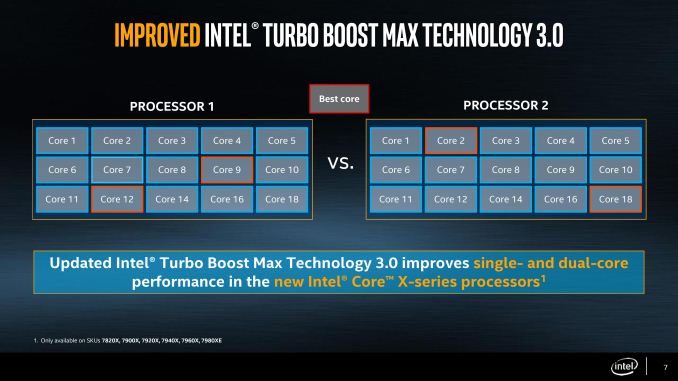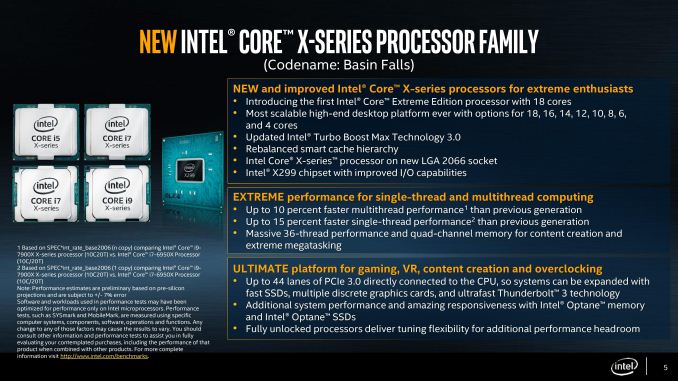Intel Announces Skylake-X: Bringing 18-Core HCC Silicon to Consumers for $1999
by Ian Cutress on May 30, 2017 3:03 AM ESTAnnouncement Four: AVX-512 & Favored Core
To complete the set, there are a couple of other points worth discussing. First up is that AVX-512 support coming to Skylake-X. Intel has implemented AVX-512 (or at least a variant of it) in the last generation of Xeon Phi processors, Knights Landing, but this will be the first implementation in a consumer/enterprise core.
Intel hasn’t given many details on AVX-512 yet, regarding whether there is one or two units per CPU, or if it is more granular and is per core. We expect it to be enabled on day one, although I have a suspicion there may be a BIOS flag that needs enabling in order to use it.
As with AVX and AVX2, the goal here is so provide a powerful set of hardware to solve vector calculations. The silicon that does this is dense, so sustained calculations run hot: we’ve seen processors that support AVX and AVX2 offer decreased operating frequencies when these instructions come along, and AVX-512 will be no different. Intel has not clarified at what frequency the AVX-512 instructions will run at, although if each core can support AVX-512 we suspect that the reduced frequency will only effect that core.
With the support of AVX-512, Intel is calling the Core i9-7980X ‘the first TeraFLOP CPU’. I’ve asked details as to how this figure is calculated (software, or theoretical), but it does make a milestone in processor design. We are muddying the waters a bit here though: an AVX unit does vector calculations, as does a GPU. We’re talking about parallel compute processes completed by dedicated hardware – the line between general purpose CPU and anything else is getting blurred.
Favored Core
For Broadwell-E, the last generation of Intel’s HEDT platform, we were introduced to the term ‘Favored Core’, which was given the title of Turbo Boost Max 3.0. The idea here is that each piece of silicon that comes off of the production line is different (which is then binned to match to a SKU), but within a piece of silicon the cores themselves will have different frequency and voltage characteristics. The one core that is determined to be the best is called the ‘Favored Core’, and when Intel’s Windows 10 driver and software were in place, single threaded workloads were moved to this favored core to run faster.
In theory, it was good – a step above the generic Turbo Boost 2.0 and offered an extra 100-200 MHz for single threaded applications. In practice, it was flawed: motherboard manufacturers didn’t support it, or they had it disabled in the BIOS by default. Users had to install the drivers and software as well – without the combination of all of these at work, the favored core feature didn’t work at all.
Intel is changing the feature for Skylake-X, with an upgrade and for ease-of-use. The driver and software are now part of Windows updates, so users will get them automatically (if you don’t want it, you have to disable it manually). With Skylake-X, instead of one core being the favored core, there are two cores in this family. As a result, two apps can be run at the higher frequency, or one app that needs two cores can participate.
Availability
Last but not least, let's talk about availability. Intel will likely announce availability during the keynote at Computex, which is going on at the same time as this news post goes live. The launch date should be sooner rather than later for the LCC parts, although the HCC parts are unknown. But no matter what, I think it's safe to say that by the end of this summer, we should expect a showdown over the best HEDT processor around.


















203 Comments
View All Comments
PUN - Tuesday, May 30, 2017 - link
AMD will ALWAYS undermine intel with pricing, regardless of either performances. Now, they can compete with similar performance at lower price, giving consumer a choice.Bullwinkle J Moose - Tuesday, May 30, 2017 - link
Time to stop bragging about who has the best A.I. and start putting it to useWhich "Intel" core count is the best "Value" for Gamers / Media Production / General Business / etc
On day 1 (when ALL core counts are finally available to the public), what is the optimum core count for software that is currently available in each category of usage
Is 4/6/8 core the best value for home use?
Is 14/16/18 core the best value for certain business case usage?
Or would 10/12/14 be the best all around value for other business classes?
Time to call Microsoft and ask what the top 20 software applications are for each usage case scenario for Windows 10 and see who has the best A.I. to figure this out
Best value vs core count on day 1 availability could be VERY different from 6 month / 1 year and 3 year mark after launch, so keep us updated!
Thanks
edzieba - Tuesday, May 30, 2017 - link
For the vast majority of consumer desktop applications (gaming, office, web browsing) you're looking at a spread of workloads from single-threaded to just about benefiting from a 4th core. Outside of video encoding, 3DCG rendering, or data analytics, there aren't that many workloads that really benefit from throwing more cores at them the handful that do are embarrassingly parallel and trivially parallellised have already moved over to GPGPU.We've heard the siren song of "We'll add more cores, and the parallellism will come!" many times over the last decade, and it has yet to happen.
Gothmoth - Tuesday, May 30, 2017 - link
i run 4 heavy apps parallel most of the time.. if i give all of them 4 cores it works very well.and yes i do video editing and 3d rendering.
people who run a lot of VM´s will love more cores also.
this is not for word processing .. but there are enough people who can make use of 16 and more cores.
Threska - Friday, June 2, 2017 - link
VMs are kind of the sneak that'll get more cores onto people's machines. In the enterprise VMs are something that's used a lot, but for desktop, not so much. But there are advantages to VMs that would benefit a desktop user, especially in this day and age, of a hostile internet, not to mention better software delivery.theuglyman0war - Thursday, June 8, 2017 - link
outside of billion dollar industries...ok?
Gothmoth - Tuesday, May 30, 2017 - link
why is there basically no covering of AMD at computex at anandtech??it´s 10 articles about intel for one about AMD?
where is an article about the displayed x399 boards?
i am wrong in my perception?
fanofanand - Wednesday, May 31, 2017 - link
Not wrong at all, I have seen just about nothing.Meteor2 - Saturday, June 3, 2017 - link
Not wrong. It's very weird how AMD have suddenly vanished from Anandtech's coverage. I don't think they even reported the Threadripper announcement a few weeks back.Gothmoth - Sunday, June 4, 2017 - link
good to know im not imagining this.seems like intel is paying anandtech a lot to not report much about AMD.
back to the 90s and intels shady tactics... so soon?
and where are the critical voices about the crippled x299 ?
linus on x299:
https://www.youtube.com/watch?v=TWFzWRoVNnE